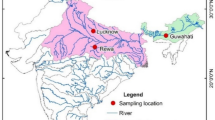Abstract
We investigated the electrophoretically detectable variation at nine protein loci in seven populations ofCyathura polita and one population of the closely relatedC. burbancki from the Atlantic coast of North America. The average proportion of the genome heterozygous per individual\((\bar H)\) inC. polita ranges from about 0% in New Brunswick and Massachusetts to 9.3% in a Georgia population.\(\bar H\) in the population ofC. burbancki was 2.6%. On the basis of our results,C. polita can be separated into two geographic forms,northern (New Brunswick, Massachusetts, and Maryland) andsouthern (Georgia and Florida). The genetic distances between the southern and northernC. polita are similar to the genetic distances reported between species of several other invertebrate groups. Our genetic data support the idea that the northern and southern forms ofC. polita andC. burbancki comprise a triad of species that diverged from each other 2–3 million years ago. Since we know nothing about the genetic structure of populations ofCyathura between Georgia and Maryland, this interpretation must be considered preliminary.
Similar content being viewed by others
Literature cited
Avise, J. C. 1974. The systematic value of electrophoretic data.Syst. Zool. 23:465–481.
Avise, J. C., M. H. Smith, andR. K. Selander. 1974. Biochemical polymorphism and systematics in the genusPeromyscus VI. Theboylii species group.J. Mammal. 55:751–763.
Burbanck, M. P., andW. D. Burbanck. 1974. Sex reversla of femaleCyathura polita (Stimpson, 1855) (Isopoda, Anthuridae).Crustaceana 26:110–112.
Burbanck, M. P., W. D. Burbanck, M. J. Dadswell, andG. F. Gillis. 1979. Occurrence and biology ofCyathura polita (Stimpson) (Isopoda, Anthuridae) in Canada.Crustaceana 37:31–38.
Burbanck, W. D. 1959. The distribution of the estuarine isopod,Cyathura sp., along the eastern coast of the United States.Ecology 40:507–511.
Burbanck, W. D. 1962. Further observations on the biotope of the estuarine isopod,Cyathura polita.Ecology 43:719–722.
Burbanck, W. D., andG. P. Burbanck. 1967. Parameters of interstitial water collected by a new sampler from the biotopes ofCyathura polita (Isopoda) in six southeastern states.Chesapeake Sci. 8:14–27.
Burbanck, W. D., andM. P. Burbanck. 1961. Variations in the dorsal pattern ofCyathura polita (Stimpson) from estuaries along the coasts of eastern United States and the Gulf of Mexico.Biol. Bull. 121:257–264.
Burbanck, W. D., andM. P. Burbanck. 1973. A study of a transplanted population of the estuarineCyathura polita (Crustacea: Isopoda), Cape Cod, Massachusetts.Assoc. Southeastern Biol. Bull. 20:42.
Burbanck, W. D., andM. P. Burbanck. 1979. Cyathura (Crustacea; Isopoda; Anthuridae), p. 293–320.In C. W. Hart and S. L. H. Fuller (eds.), Pollution Ecology of Estuarine Invertebrates. Academic Press, New York.
Burbanck, W. D., C. G. Goodchild, E. S. Dennis, C. E. Styron, andM. P. Burbanck. 1969. Chromatographic studies of three species ofCyathura (Isopoda, Anthuridae) andLirceus fontinalis (Isopoda, Asellota).Verh. Internat. Verein. Limnol. 17:848–854.
Burbanck, W. D., R. Grabske, andJ. R. Comer. 1964. The use of the radioisotope, Zinc 65, in a preliminary study of population movements of the estuarine isopod,Cyathura polita (Stimpson, 1855).Crustaceana 7:17–20.
Davis, B. J. 1964. Disc electrophoresis. II. Method and application to human serum proteins.Ann. N.Y. Acad. Sci. 212:404–427.
Frankenberg, D., andW. D. Burbanck. 1963. A comparison of the physiology and ecology of the estuarine isopodCyathura polita in Massachusetts and Georgia.Biol. Bull. 125:81–95.
Harris, H. 1970. The Principles of Human Biochemical Genetics. American Elsevier, New York. 328 p.
Hubby, J. L., andR. C. Lewontin. 1966. A molecular approach to the study of genic heterozygosity in natural populations. I. The number of alleles at different loci inDrosophila pseudoobscura.Genetics 54:577–594.
Johnson, W. E., andR. K. Selander. 1971. Protein variation and systematics in kangaroo rats (GenusDipodomys).Syst. Zool. 20:377–405.
King, J. L., andT. H. Ohta. 1975. Polyallelic mutational equilibria.Genetica 79:681–691.
Lewontin, R. C. 1974. The Genetic Basis of Evolutionary Change. Columbia Univ. Press, New York. 346 p.
Miller, M. A., andW. D. Burbanck. 1961. Systematics and distribution of an estuarine isopod crustacean,Cyathura polita (Stimpson, 1855), new comb., from the Gulf and Atlantic seaboard of the United States.Biol. Bull. 120:62–84.
Nei, M. 1972. Genetic distance between populations.Am. Nat. 106:283–292.
Nei, M. 1975. Molecular Population Genetics and Evolution. American Elsevier, New York. 288 p.
Nei, M., andA. K. Roychoudhury. 1974. Sampling variances of heterozygosity and genetic distance.Genetics 76:379–390.
Nevo, E. 1978. Genetic variation in natural populations: patterns and theory.Theor. Popul. Biol. 13:121–177.
Schaal, B. A., and W. W. Anderson. 1974. An outline of techniques for starch gel electrophoresis of enzymes from the American oysterCrassostrea virginica Gmelin.Georgia Marine Science Center, Tech. Report #74-3.
Segal, E., andW. D. Burbanck. 1963. Effects of salinity and temperature on osmoregulation in two latitudinally separated populations of an estuarine isopod,Cyathura polita (Stimpson).Physiol. Zool. 36:250–263.
Selander, R. K., M. H. Smith, S. Y. Yang, W. E. Johnson, andJ. B. Gentry. 1971. Biochemical polymorphism and systematics in the genusPeromyscus I. Variation in the old-field mouse. Studies Genet. VI.Univ. Texas Publ. 7103:49–90.
Author information
Authors and Affiliations
Rights and permissions
About this article
Cite this article
Parker, E.D., Burbanck, W.D., Burbanck, M.P. et al. Genetic differentiation and speciation in the estuarine isopodsCyathura polita andCyathura burbancki . Estuaries 4, 213–219 (1981). https://doi.org/10.2307/1351477
Issue Date:
DOI: https://doi.org/10.2307/1351477




